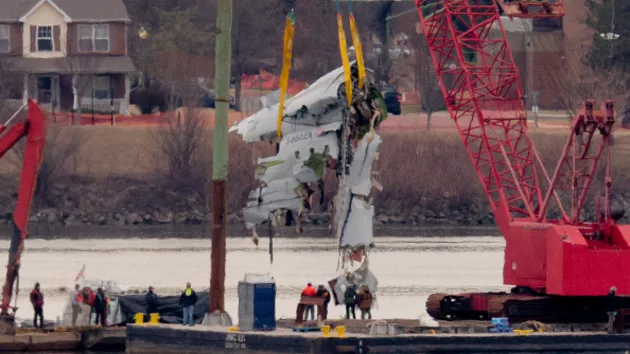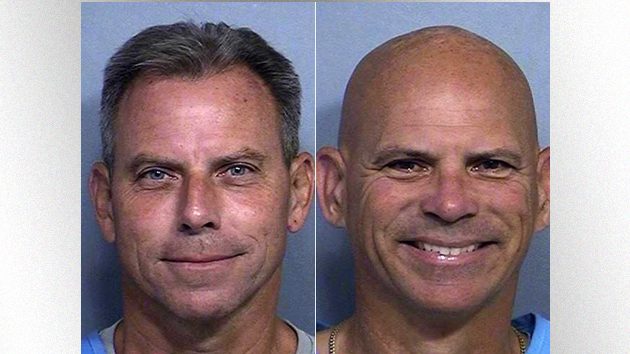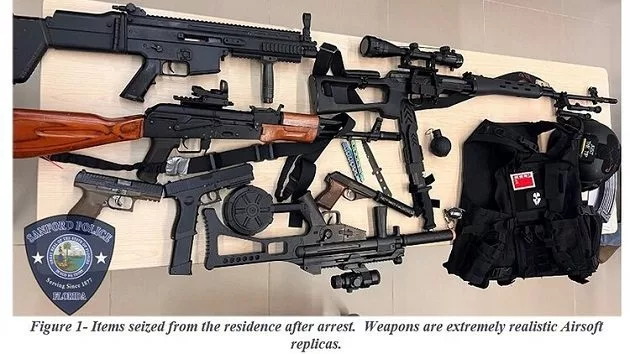(WASHINGTON) — Even as crews continued to comb the Potomac River for the remains of victims, the Army Corps of Engineers began on Monday the delicate task of removing from the frigid water the wreckage of American Airlines Flight 5342 and a military Black Hawk helicopter that collided in midair last week near Ronald Reagan Washington National Airport.
With the roar of commercial jets taking off and landing from the airport’s nearby runway, and against the backdrop of the U.S. Capitol Building, the salvage operation began at the crack of dawn, officials said.
A large crane on a barge in the middle of the icy river had lifted one of the passenger plane’s engines and the aircraft’s crumpled fuselage from the river by noon, Col. Francis Pera of the U.S. Army Corps of Engineers, Baltimore District, said at a news conference Monday afternoon. He said crews began lifting a wing of the passenger plane from the water at about 2:30 p.m.
The pieces were moved to a flatbed trailer to be taken on Tuesday to a nearby hanger where investigators from the National Transportation Safety Board will search for answers to what caused the deadliest U.S. air disaster in 16 years.
Pera said the goal for Tuesday is to bring the jet’s cockpit to the surface.
The crash killed 64 passengers and crew aboard the regional jet and the three-person flight crew aboard the Black Hawk, which was on a nighttime training mission when it crashed into the jet, officials said.
At least 55 victims have been removed from the river and positively identified by the Office of the Chief Medical Examiner, D.C. Assistant Fire Chief Gary Steen said at Monday afternoon’s news conference.
“Our process is committed to the dignified recovery of the remains of personnel and passengers of the flight,” Pera said.
During Monday’s operation, several work stoppages were ordered to recover multiple sets of remains amid the wreckage, Pera said. Those remains were removed and taken to the medical examiner for identification.
“Should any remains be found during our process, an automatic work stoppage happens and we will definitely begin to begin the proper coordination with the appropriate authorities. Reuniting those lost in the tragic incident is really what keeps us all going. We’ve got teams that have been working this since the beginning and we’re committed to making this happen,” Pera said.
He added that preparation for the salvage operation began on Friday, with divers equipped with multiple cameras surveying the submerged wreckage, focusing on large pieces of wreckage to remove from the river first. He said that during the survey on Saturday, remains were also recovered from the water.
“I just want to make sure that everyone is crystal clear in understanding that all salvage operations will be completed in close coordination with the Unified Command, all of our partners just really to ensure strict adherence to our central priority that the dignified recovery of missing flight passengers and personnel takes precedence,” Pera said at a news conference on Sunday.
Crews working with multiple agencies, including the Navy and 200 members of the U.S. Coast Guard, conducted rehearsals on the best way to remove the wreckage while simultaneously preparing for the discovery of more victims, according to Pera.
“We’ve got a wide debris field. Within that wide debris field, we’re employing different techniques to make sure we understand what’s in the water,” Pera said.
Family members of the crash victims were driven to the banks of the Potomac River on Sunday to pay respects to their lost loved ones. Among those killed in the crash were a civil rights attorney, a biology professor, several champion figure skaters and many others.
“These people have suffered a terrible loss and they’re grieving and I think that that’s exactly what you’d expect,” said Fire Chief John Donnelly of the Washington, D.C., Fire Department, who has visited with the families. “There’s a whole range of emotions in that. I would say they are a strong group of families that are focused on getting their loved ones back, and I think that’s the appropriate place to be at this point.”
If pieces of wreckage removed from the water contain remains, those pieces will be moved close to a barge and a tent will be erected so “we have full discretion and then we will bring in proper personnel to deal with at the time,” Pera explained.
Donnelly said that local teams will continue to search the shoreline and around the river to make sure that all the debris is collected.
“And if by chance as a member of the public you come across some of that, you should call 911 and report it to them and we will get it taken care of and get it examined,” Donnelly said.
Donnelly called the salvage and recovery mission a “tough operation” for those doing the work. He said each agency supporting the mission has peer counselors to help divers and others working to clear the river to cope with the grim task.
“For our first responders, all of the people that are coming in here to support, this is a tough operation — and if you are a responder listening to this, we want you to know that you can have a lot of different feelings about this, and there are people out here to help you,” Donnelly said.
Copyright © 2025, ABC Audio. All rights reserved.






